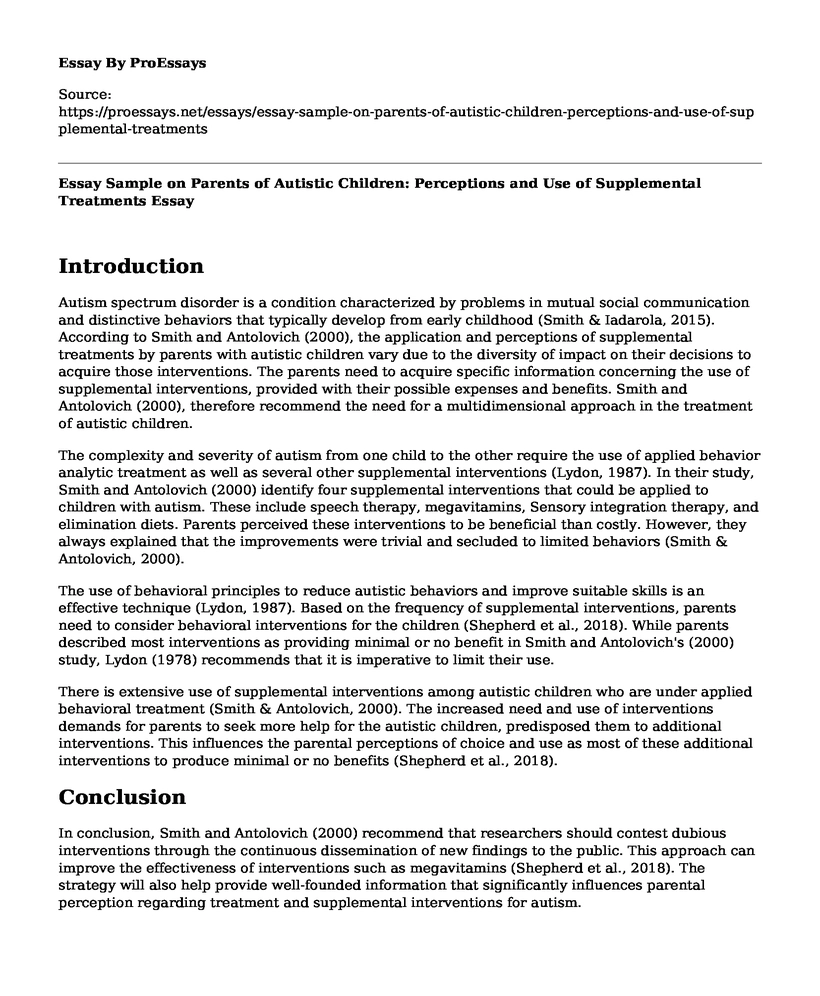Introduction
Autism spectrum disorder is a condition characterized by problems in mutual social communication and distinctive behaviors that typically develop from early childhood (Smith & Iadarola, 2015). According to Smith and Antolovich (2000), the application and perceptions of supplemental treatments by parents with autistic children vary due to the diversity of impact on their decisions to acquire those interventions. The parents need to acquire specific information concerning the use of supplemental interventions, provided with their possible expenses and benefits. Smith and Antolovich (2000), therefore recommend the need for a multidimensional approach in the treatment of autistic children.
The complexity and severity of autism from one child to the other require the use of applied behavior analytic treatment as well as several other supplemental interventions (Lydon, 1987). In their study, Smith and Antolovich (2000) identify four supplemental interventions that could be applied to children with autism. These include speech therapy, megavitamins, Sensory integration therapy, and elimination diets. Parents perceived these interventions to be beneficial than costly. However, they always explained that the improvements were trivial and secluded to limited behaviors (Smith & Antolovich, 2000).
The use of behavioral principles to reduce autistic behaviors and improve suitable skills is an effective technique (Lydon, 1987). Based on the frequency of supplemental interventions, parents need to consider behavioral interventions for the children (Shepherd et al., 2018). While parents described most interventions as providing minimal or no benefit in Smith and Antolovich's (2000) study, Lydon (1978) recommends that it is imperative to limit their use.
There is extensive use of supplemental interventions among autistic children who are under applied behavioral treatment (Smith & Antolovich, 2000). The increased need and use of interventions demands for parents to seek more help for the autistic children, predisposed them to additional interventions. This influences the parental perceptions of choice and use as most of these additional interventions to produce minimal or no benefits (Shepherd et al., 2018).
Conclusion
In conclusion, Smith and Antolovich (2000) recommend that researchers should contest dubious interventions through the continuous dissemination of new findings to the public. This approach can improve the effectiveness of interventions such as megavitamins (Shepherd et al., 2018). The strategy will also help provide well-founded information that significantly influences parental perception regarding treatment and supplemental interventions for autism.
Cite this page
Essay Sample on Parents of Autistic Children: Perceptions and Use of Supplemental Treatments. (2023, Apr 23). Retrieved from https://proessays.net/essays/essay-sample-on-parents-of-autistic-children-perceptions-and-use-of-supplemental-treatments
If you are the original author of this essay and no longer wish to have it published on the ProEssays website, please click below to request its removal:
- Paper Example on Language and Cross-Cultural Communication
- Research Paper on Terrorism in America in Today's Society
- Financial Stress and Domestic Violence: The Startling Link - Essay Sample
- Essay on Understanding Turner Syndrome: A Chromosomal Abnormality Affecting Females
- Essay Example on J. al-Afghani: The Father of Islamic Modernism
- Paper Sample on 4 Studies Show How Exercise Can Help Alleviate Depression
- Essay Exampe on The Health Inequality Crisis: A Reflection of My Experience







